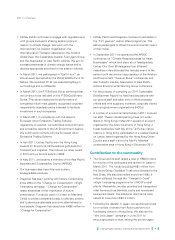Cathay Pacific 2011 Annual Report Download - page 20
Download and view the complete annual report
Please find page 20 of the 2011 Cathay Pacific annual report below. You can navigate through the pages in the report by either clicking on the pages listed below, or by using the keyword search tool below to find specific information within the annual report.
18
Business on the Sri Lanka route was generally robust,
but continues to be hampered by the difficulty of
obtaining visas for travel to and through Hong Kong.
The same difficulty applies in respect of other South
Asian routes (Dhaka, Kathmandu and Karachi).
We added Abu Dhabi to the network in June 2011.
This is our fifth destination in the Middle East. Load
factor on the route was below expectations initially but
has been gradually improving.
Our business to and from the Middle East in general
was disappointing in 2011. The political unrest in the
region affected demand for travel, as did the economic
outlook. Premium class revenues increased by less
than the capacity growth.
Southeast Asia
Business on most Southeast Asian routes was strong
in all classes in 2011. We added capacity on the
Singapore and Indonesia routes in the summer.
In the first half of the year, demand for travel to and
from Thailand returned to the levels experienced
before the 2010 political unrest. However, in October
2011, heavy flooding in the country began to have a
significant impact on inbound and outbound travel. We
reduced capacity on the Bangkok route as demand fell
but had restored it in full by end of December.
Demand for travel to and from Singapore was
consistently strong in the first three quarters in 2011,
despite intense competition on the route. In July 2011,
we increased the number of our flights on the route
from seven to eight per day.
The Penang route benefited from becoming a daily
direct service in the summer. The Kuala Lumpur route
remained robust.
•
•
•
•
•
•
•
Demand for travel to and from Indonesia grew strongly
in 2011. We increased the service to Surabaya to daily
in March. We increased the service to Jakarta to three
times daily in August. We put on extra flights to
Indonesia in response to strong demand over the
Lebaran holiday. Demand on the Bali route was
satisfactory despite an increasing number of direct
flights from Europe.
Overall demand for travel to and from the Philippines
continued to be adversely affected by the hostage
incident in Manila 2010. However, demand for
premium class travel was strong and this offset in part
the effect of the reduction in demand for economy
class travel. The performance of Dragonair’s service to
Manila continued to improve.
Southwest Pacific and South Africa
Premium class revenue increased more than capacity
on the Southwest Pacific routes, assisted by the
strength of the Australian currency and the introduction
of our new business class product on the Sydney route
in March 2011. Economy class business was adversely
affected by increased competition, with more carriers
providing direct flights to and from Mainland China.
Demand on the New Zealand route was satisfactory.
Capacity was increased for the southern hemisphere
summer. There was a big increase in traffic during for
the Rugby World Cup in October 2011.
Business on the South Africa route was relatively weak
in the first half of the year, with a reduction in traffic
compared with the previous year (which had benefited
from the FIFA World Cup). However, towards the end
of the year there was an improvement in traffic on the
route, particularly from economy class travellers.
•
•
•
•
•
Review of Operations PASSENGER SERVICES
























